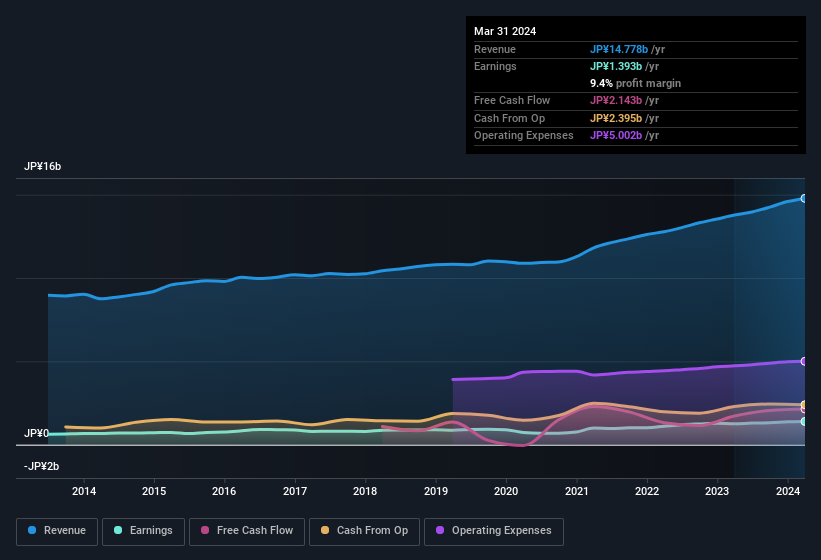- Japan
- /
- Medical Equipment
- /
- TSE:7634
Hoshi Iryo-Sanki's (TSE:7634) Earnings May Just Be The Starting Point

Even though Hoshi Iryo-Sanki Co., Ltd.'s (TSE:7634) recent earnings release was robust, the market didn't seem to notice. Investors are probably missing some underlying factors which are encouraging for the future of the company.
View our latest analysis for Hoshi Iryo-Sanki

Examining Cashflow Against Hoshi Iryo-Sanki's Earnings
As finance nerds would already know, the accrual ratio from cashflow is a key measure for assessing how well a company's free cash flow (FCF) matches its profit. In plain english, this ratio subtracts FCF from net profit, and divides that number by the company's average operating assets over that period. The ratio shows us how much a company's profit exceeds its FCF.
That means a negative accrual ratio is a good thing, because it shows that the company is bringing in more free cash flow than its profit would suggest. That is not intended to imply we should worry about a positive accrual ratio, but it's worth noting where the accrual ratio is rather high. To quote a 2014 paper by Lewellen and Resutek, "firms with higher accruals tend to be less profitable in the future".
For the year to March 2024, Hoshi Iryo-Sanki had an accrual ratio of -0.11. That implies it has good cash conversion, and implies that its free cash flow solidly exceeded its profit last year. In fact, it had free cash flow of JP¥2.1b in the last year, which was a lot more than its statutory profit of JP¥1.39b. Hoshi Iryo-Sanki's free cash flow improved over the last year, which is generally good to see.
Note: we always recommend investors check balance sheet strength. Click here to be taken to our balance sheet analysis of Hoshi Iryo-Sanki.
Our Take On Hoshi Iryo-Sanki's Profit Performance
Hoshi Iryo-Sanki's accrual ratio is solid, and indicates strong free cash flow, as we discussed, above. Because of this, we think Hoshi Iryo-Sanki's earnings potential is at least as good as it seems, and maybe even better! And on top of that, its earnings per share have grown at 43% per year over the last three years. At the end of the day, it's essential to consider more than just the factors above, if you want to understand the company properly. Just as investors must consider earnings, it is also important to take into account the strength of a company's balance sheet. If you're interested we have a graphic representation of Hoshi Iryo-Sanki's balance sheet.
Today we've zoomed in on a single data point to better understand the nature of Hoshi Iryo-Sanki's profit. But there are plenty of other ways to inform your opinion of a company. For example, many people consider a high return on equity as an indication of favorable business economics, while others like to 'follow the money' and search out stocks that insiders are buying. While it might take a little research on your behalf, you may find this free collection of companies boasting high return on equity, or this list of stocks with significant insider holdings to be useful.
If you're looking to trade Hoshi Iryo-Sanki, open an account with the lowest-cost platform trusted by professionals, Interactive Brokers.
With clients in over 200 countries and territories, and access to 160 markets, IBKR lets you trade stocks, options, futures, forex, bonds and funds from a single integrated account.
Enjoy no hidden fees, no account minimums, and FX conversion rates as low as 0.03%, far better than what most brokers offer.
Sponsored ContentValuation is complex, but we're here to simplify it.
Discover if Hoshi Iryo-Sanki might be undervalued or overvalued with our detailed analysis, featuring fair value estimates, potential risks, dividends, insider trades, and its financial condition.
Access Free AnalysisHave feedback on this article? Concerned about the content? Get in touch with us directly. Alternatively, email editorial-team (at) simplywallst.com.
This article by Simply Wall St is general in nature. We provide commentary based on historical data and analyst forecasts only using an unbiased methodology and our articles are not intended to be financial advice. It does not constitute a recommendation to buy or sell any stock, and does not take account of your objectives, or your financial situation. We aim to bring you long-term focused analysis driven by fundamental data. Note that our analysis may not factor in the latest price-sensitive company announcements or qualitative material. Simply Wall St has no position in any stocks mentioned.
About TSE:7634
Hoshi Iryo-Sanki
Manufactures and sells pharmaceutical medical oxygen and nitrous oxides in Japan.
Flawless balance sheet, good value and pays a dividend.
Market Insights
Community Narratives



